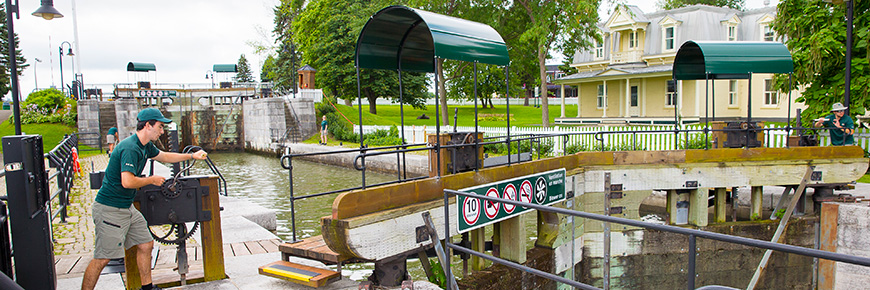
How locks work
Lachine Canal National Historic Site
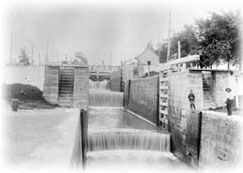 Locks
1, 2 and 3 of the Chambly Canal in 1904.
Locks
1, 2 and 3 of the Chambly Canal in 1904.© National Archives of Canada
Most of Canada's canals consist of a series of locks allowing boats to overcome obstacles such as dams, rapids, sandbars and rocky riverbeds. This type of construction is one of the safest, most efficient methods of avoiding obstacles on a waterway.
A lock usually consists of a watertight basin known as a lock chamber, which is used to raise or lower the water level as required. Boats are raised or lowered by filling or emptying the lock chamber. Gates at each end of the lock chamber allow the boats to enter and leave. The gates are operated by various hydraulic, electric or manually operated systems, depending on the canal.
Sluices in the gates or walls of the locks are operated to fill and empty the lock chambers by gravity using the communicating vessels principle.
If the drop that the lock allows boats to negotiate is spread over a distance, a canal is built providing access to the lock.
Other works similar to the conventional lock system perform the same function for boats. These are hydraulic locks and boat lifts .
Conventional lock
How a conventional lock operates for a boat heading upstream:
- The boat enters the lock at the lower level.
- The lock gates and lower sluices close, making the lock chamber watertight.
- The upper sluices are then opened, allowing the water to enter the lock by gravity and raise the boat.
- When the water level in the lock is the same as that in the upstream portion of the canal, the upper gates are opened and the boat continues its journey upstream.
For boats heading downstream, the operation is reversed:
- The boat enters the lock at the upper level.
- The upper lock gates and sluices are closed to make the lock chamber watertight.
- The lower sluices are then opened, allowing the water that is above the level of the lower water level to flow out.
- When the water level is the same on both sides of the lower gates, they are opened and the boat continues on its way downstream.
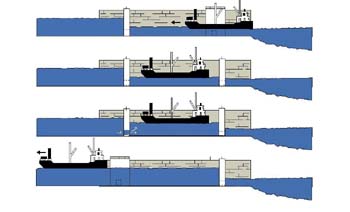 How
a conventional lock works.
How
a conventional lock works.Boat lift
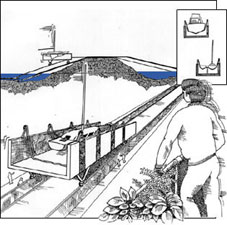 Boat
lift
Boat
liftA boat lift consists of a flat wagon mounted on rails linking two bodies of water separated by an obstacle. The boats are towed onto the wagon, which is then hoisted out of the water by a winch at the top of the obstacle. The wagon then goes down the opposite side by gravity, into the second body of water.
The boat lift system is used at Big Chute, Ontario, on the Trent-Severn Waterway. It prevents the migration of fish species from one body of water to another.
Hydraulic Lock
A hydraulic lock consists of two lock chambers that can move up and down, acting as counterweights to each other, by means of a hydraulic system. Each lock chamber rests on a huge piston. As this piston moves up and down in its cylindrical casing, it pushes on the piston of the other lock chamber, which moves upwards. The lock at Peterborough, Ontario works in this way.
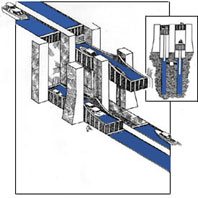 Hydraulic
locks
Hydraulic
locks- The upper lock chamber contains more water than the lower lock chamber. It is therefore heavier.
- When the sluice linking the two cylinders is open, the upper lock chamber, which is heavier, goes down, and the piston on which it rests displaces an equivalent volume of water, which is pushed into the second cylinder. This activates the other piston and raises the lower lock chamber.
- When the lower lock chamber has reached the same level as the upper one, the sluice closes. The other lock chamber is now at the lower level.
- The gates of both chambers open, linking each lock chamber to its tailbay, but at such a level that additional water flows into the upper lock chamber and the lower lock chamber discharges the same amount.
- The boats leave the chambers and other boats enter. The gates are closed, the sluice is reopened and, because it is heavier, the upper lock chamber starts to lower, causing the other lock chamber to rise.
- Date modified :